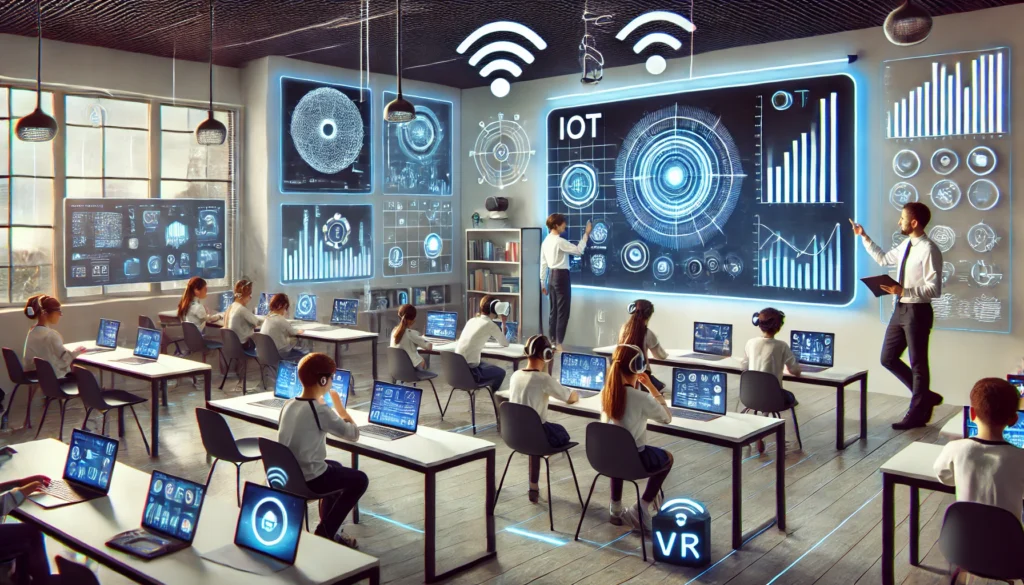
Introduction
The Internet of Things (IoT) is reshaping various industries, and education is no exception. By connecting devices to create smarter, more interactive environments, IoT in education is enhancing the way students learn, educators teach, and institutions operate. This article explores the transformative potential of IoT in education, its applications, benefits, and challenges.
What is IoT in Education?
Defining
IoT in education refers to the integration of interconnected devices and systems into educational settings. These devices, such as smartboards, connected tablets, and wearable tech, communicate with each other to facilitate seamless data exchange. This technology is enabling educators and students to interact in dynamic and engaging ways.
The Role of IoT in Modern Classrooms
IoT plays a pivotal role in modern classrooms by personalizing learning experiences. For instance, smart devices can track a student’s progress and provide tailored feedback, ensuring no one falls behind.
Applications
Smart Classrooms
One of the most visible applications of IoT in education is the development of smart classrooms. Features such as automated lighting, temperature control, and interactive whiteboards make learning environments more comfortable and engaging.
Example: Interactive Whiteboards
Interactive whiteboards, connected via IoT, allow teachers to present information dynamically. Students can interact with content directly, making lessons more participatory.
Attendance and Security Systems
IoT-powered systems automate attendance tracking and enhance campus security. For example, facial recognition or RFID tags streamline attendance, saving valuable time for educators.
Real-Time Alerts
Connected security systems send real-time alerts in case of emergencies, ensuring a safer environment for students and staff.
Personalized Learning Platforms
IoT devices enable personalized learning by collecting data on a student’s progress. This data helps educators identify strengths and weaknesses, allowing for customized learning plans.
Benefits
Enhanced Student Engagement
By making lessons interactive, IoT increases student engagement. Devices like virtual reality (VR) headsets transport students to immersive environments, transforming abstract concepts into tangible experiences.
Improved Accessibility
IoT in education has significantly improved accessibility for students with disabilities. For example, connected hearing aids or voice-to-text applications ensure inclusivity in the classroom.
Streamlined Administrative Tasks
IoT automates administrative tasks, such as grading and attendance tracking, freeing up time for educators to focus on teaching.
Challenges
Data Privacy Concerns
While IoT offers numerous benefits, it also raises concerns about data privacy. Schools must implement robust security measures to protect sensitive student information.
High Initial Costs
The initial cost of implementing IoT in education can be prohibitive for some institutions. However, long-term savings and efficiency often outweigh these expenses.
The Future
Expanding Applications
The future of IoT in education looks promising. From AI-driven learning assistants to augmented reality (AR) tools, new technologies continue to push the boundaries of what’s possible.
Bridging Global Gaps
IoT in education has the potential to bridge global gaps in learning resources. Connected devices can deliver quality education to remote and underserved areas, ensuring inclusivity.
Conclusion
IoT in education is transforming traditional learning environments into dynamic, connected ecosystems. While challenges remain, the benefits far outweigh the drawbacks, making it an essential tool for the future of education. As we embrace this technological revolution, the possibilities for innovation and improvement in learning are limitless.
By integrating IoT into classrooms, educators can create engaging, efficient, and accessible learning environments for all.
READ MORE :
- https://rmm.abyadi.com/the-economic-impact-of-iot/
- https://rmm.abyadi.com/the-roleof-iot-in-healthcare/
- https://rmm.abyadi.com/iot-in-transportation-smart-cities/